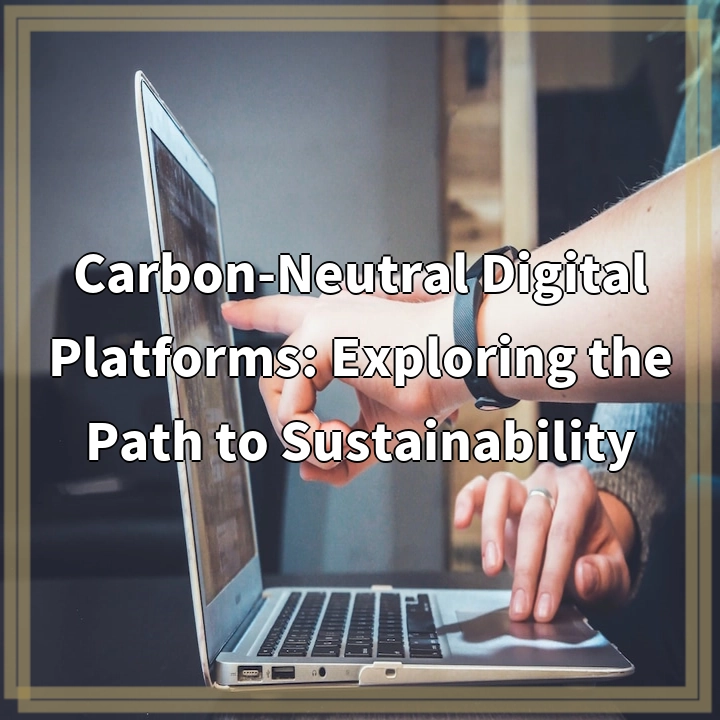
What is Carbon-Neutral Digital Platforms?
Carbon-neutral digital platforms refer to online services, applications, and websites that strive to minimize or offset their carbon footprint. These platforms aim to reduce the environmental impact associated with their operations, such as energy consumption and greenhouse gas emissions. By implementing sustainable practices and utilizing renewable energy sources, these platforms work towards achieving net-zero emissions and ensuring a more sustainable digital landscape.
Real-World Problems Associated with Carbon-Neutral Digital Platforms
While the concept of carbon-neutral digital platforms is commendable, several challenges and real-world problems still need to be addressed to achieve meaningful sustainability. Let’s explore some of these issues:
1. Energy Consumption
One of the major challenges faced by carbon-neutral digital platforms is the energy consumption associated with data centers and server infrastructure. These facilities require large amounts of electricity to power and cool the servers, resulting in significant carbon emissions. Finding solutions to minimize energy consumption and transitioning to renewable energy sources is crucial to address this problem.
2. Scope of Offset Initiatives
Carbon-neutral digital platforms often rely on offset initiatives to compensate for their remaining emissions. However, the effectiveness of these offset programs is sometimes questioned. It is important to ensure that the offset projects chosen are credible, verifiable, and truly contribute to reducing greenhouse gas emissions. Ongoing monitoring and transparent reporting are necessary to maintain credibility.
3. Life Cycle Assessment
Another challenge is conducting a comprehensive life cycle assessment (LCA) of digital platforms. This assessment involves evaluating the entire lifespan of a platform, including the manufacturing of devices, the production and transportation of data servers, and the disposal of electronic waste. Understanding and mitigating the environmental impacts at each stage of the life cycle is essential for a holistic sustainability approach.
4. User Behavior and Awareness
The behavior and awareness of platform users also play a significant role in achieving carbon neutrality. Encouraging users to adopt eco-friendly practices, such as minimizing data usage, optimizing device settings, and supporting sustainable initiatives, can contribute to reducing overall emissions. Educating users about the environmental impact of their digital activities is crucial for driving meaningful change.
Conclusion
Carbon-neutral digital platforms hold great promise for mitigating the environmental impact of the digital world. By addressing the challenges associated with energy consumption, offset programs, life cycle assessment, and user behavior, these platforms can make significant strides towards sustainability. Embracing renewable energy sources, implementing energy-efficient technologies, and fostering user awareness are key to forging a path towards a carbon-neutral digital landscape.

Solutions for Carbon-Neutral Digital Platforms
The challenges faced by carbon-neutral digital platforms can be addressed through the following solutions:
1. Energy Efficiency and Renewable Energy
Efforts should be focused on minimizing energy consumption by utilizing energy-efficient technologies, optimizing server infrastructure, and adopting renewable energy sources such as solar or wind power. This shift towards cleaner energy will help reduce carbon emissions associated with digital platforms.
2. Robust Offset Programs
Ensuring the effectiveness of offset initiatives is crucial. Carbon-neutral platforms should carefully select offset projects that meet rigorous standards and have a verifiable impact on reducing greenhouse gas emissions. Transparent reporting and ongoing monitoring are key to maintaining the integrity of these offset programs.
3. Comprehensive Life Cycle Assessment
Consideration of the entire life cycle of digital platforms is essential for identifying and addressing environmental hotspots. Conducting thorough life cycle assessments can help identify areas for improvement, such as reducing emissions associated with manufacturing, transportation, and disposal of devices and data servers.
4. User Education and Engagement
Promoting user awareness and encouraging sustainable behaviors can significantly contribute to carbon neutrality. Digital platforms should educate users about the environmental impact of their online activities and provide guidance on how to reduce their carbon footprint. Engaging with users through interactive campaigns and incentives can foster a collective effort towards sustainability.
Conclusion
By implementing energy-efficient practices, utilizing renewable energy, selecting credible offset programs, conducting comprehensive life cycle assessments, and engaging users in sustainable behaviors, carbon-neutral digital platforms can pave the way to a more environmentally friendly digital landscape. These solutions are essential for achieving the goal of carbon neutrality and ensuring a sustainable future.















